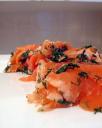Gravlax, by default
I grew up watching many sitcom families celebrate Christmas in the utmost traditional way possible – chestnuts roasting by the fire, carols, snow, roast turkey and stuffing. Naturally, I wanted all of that. Unfortunately, the harsh reality is that Christmas in Sydney occurs in the summertime, where none of those traditions make sense. Santa would lose pounds under the weight of all that red wooly fabric. Reindeers could collapse from heat exhaustion. Frosty the Snowman would be the guy in a truck playing Greensleeves down your street.
Still, our family persisted. Breaking point might have come perhaps, when we came over for Christmas one year and mom had the air-conditioning on full blast while trying to roast a turkey. We worked our way through the bird and all it’s trimmings in a relative comfort of a powerful air conditioner, but it was hard work stepping back into the harsh 35+’C heat of the outside world. Something had to give. Next year, mom declared that it was going to be a turkey-free zone. Since then, it has been a happy gathering of fresh salads, oysters, sashimi, and the odd leg of cold glazed ham (with a few extra bits to take home and consume in increasingly creative ways – ham sandwiches, ham omelettes, ham fried rice, ham …).
I made some gravlax recently, that reminded me of our Christmas cold lunches – light, refreshing and tasty. It is gravlax “by default” because when I started this recipe, I didn’t want to cure a whole side of salmon. Instead, I bought a single portion and scaled down the ingredients accordingly. The thing I forgot to consider, was that such a small portion of fish would not require the same curing time. When it came to slicing and tasting, I found it a bit too salty, and remedied this by cleaning off the excess salt and marinating the cured fish in a good splash of verjuice. A day later and the slices of fish were absolutely perfect. We had this with thin toasted bread and some tomato salsa. Maybe I should have cured a whole side afterall!
Gravlax, or Gravadlax, is traditionally a Scandinavian dish, and literally means “salmon from the grave”, when it used to be preserved by burying the fish in the sand. These days it is merely marinated in salt, dill and sugar, with variations such as vodka and beetroot juice creeping into recipes I have spied in some books. My recipe comes from the very interesting book, Preserved, by Nick Sandler and Johnny Acton.
Gravlax :
1 salmon fillet, skin on
For every 1 kg salmon you need :
50g coarse sea salt
50g granulated sugar
1/2 teaspoon freshly milled black pepper
zest of 2 lemons
50g roughly chopped fresh dill
Trim the salmon fillet and remove the rib and pin bones.
Place the salmon in a shallow dish, skin side down. Cover it with the curing ingredients and rub them thoroughly in. This isn’t exactly traditional, but cover the dish with a layer of clingfilm. Place a heavy chopping board or a smaller board weighed down with a pile of plates on the surface of the clingfilm and put it all in the fridge. Compressing the salmon helps to create a firmer, drier gravadlax.
After 24 hours, pour off the excess liquid and turn the salmon over. Return it to the fridge, weigh it down again and leave for another 24 hours.
The gravadlax is now ready. Uncarved, it will keep for another 5 days. To serve it, take a long, sharp knife and slice the fish diagonally, starting at the tail end. Greasing the knife with a smidgen of oil will make the carving easier. Gravadlax is delicious served with hot blinis and creme fraiche mixed with mustard.
(This is my contribution to Nihowera’s Mid-Winter Christmas Feast for 2007.)











